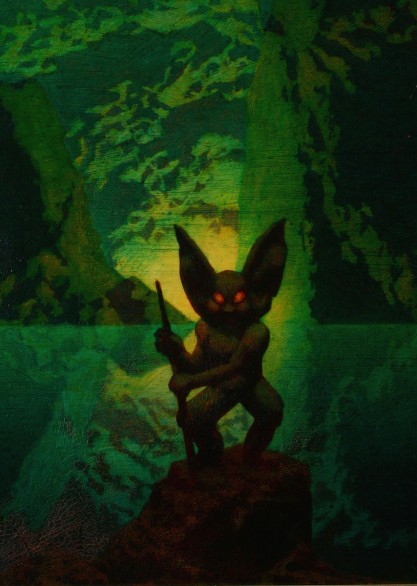
 |
| Above: Verso title in artist’s hand |


A haunting and technically masterful painting on board by science fiction and pulp illustrator Hannes Bok, the first artist to win the prestigious Hugo Award. In 1954, Bok contributed this image for the back cover plate of Destiny – No.10, the early sci-fi fanzine published to coincide with the 12th World’s Science Fiction Convention in San Francisco. In that usage, the Tolkien-esque martian illustrates the the Richard E. Geis poem “Kill Me Earthmen.”
 |
| Above: The artwork as it appeared in “Destiny #10”, 1954 |
The image features a glowing alien standing guard over ominous caves in an other-wordly landscape. This is titled on verso “Sentry” and is dated 1944, lower right. Bok worked using a technique popularized by his mentor Maxfield Parrish – painstakingly adding layer after layer of semi-translucent glazes to get the ethereal, luminous color effect that defines his work.

One of our favorite illustrators, Bok was born Wayne Woodard and grew up in Duluth, Minnesota. As an adult, the artist carved out a meager living as an illustrator and “part time astrologer.” What we love most about Bok is his steadfast idealism and refusal to conform to the whims and rigors of publishing trends. Not surprisingly Bok died penniless in New York City. As today’s collectors and scholars unearth the lost history of the pulps the star of Hannes Bok burns brighter than at any time during his long and prolific career.
His paintings graced various covers of mid-tier pulp magazines and some book covers (Arkham House in particular) in the mid-20th century. Bok hung out with the L.A. Clifton’s Cafeteria sci-fi crew in the 1930s. He was represented professionally by Ray Bradbury who saw promise in the unique vision and gift that was the enigma Hannes Bok.

